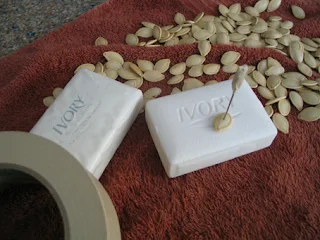 |
| Nut head dolls, strung seed bodies by kathy grimm. |
Supply List:
- a handful of small wooden beads
- two acorns, include their caps
- dental floss
- an embroidery needle, not too large (some of these have blunt ends more suitably designed for young crafters)
- wood glue as needed
- soft bristle tooth-brush
Directions:
- Clean and dry all to the seeds and nuts that you have collected in advance with a soft tooth brush. I have already included directions in an earlier project that explain how to string pumpkin seeds.
- I decided to string together my selection in a pattern. This reinforces important concepts about design to small students. You can also talk to them about simple math during this activity as well.
- Thread your needle with dental floss and string together the bodies.
- I attached the acorn heads with wood glue after stringing the bodies. Parents may decide that this requires a bit of patience. They may wish to hot glue the acorns to the seed bodies instead so that there is less drying time needed before the project is finished. Sometimes little folk get very anxious about playing with these nut head dolls so, parents may hurry the craft along in order to please their interests.
- A word of warning. Do not give these little dolls to infants who may choke on the nuts! This project is appropriate for five year old children and up.
Additional Suggestions: Sometimes parents get interested in crafts that they intend for their children. This is often the case in the making of nut head dolls! So harvest enough seeds and nuts to make a few for yourself. I enjoy hanging my own samples on the Christmas tree every year. This is, in fact, a very old folksy tradition. Craft artists living in the Appalachian mountains used to make this kind of folk doll to sell to tourists. It was a popular craft around 1910. I still can find nut head dolls in flee markets on a rare occasion.
 |
| The nut head people finally rest after I have spent an hour in the park looking for their heads. |
 |
| I chose to string these dangling nut people with a variety of pumpkin seeds, wooden beads, and acorns. |


















